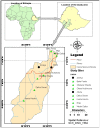An ethnobotanical study of medicinal plants used by local people in the lowlands of Konta Special Woreda, southern nations, nationalities and peoples regional state, Ethiopia
- PMID: 19775482
- PMCID: PMC2764637
- DOI: 10.1186/1746-4269-5-26
An ethnobotanical study of medicinal plants used by local people in the lowlands of Konta Special Woreda, southern nations, nationalities and peoples regional state, Ethiopia
Abstract
Background: Research was carried out in Konta Special Woreda (District); it is a remote area with lack of infrastructure like road to make any research activities in the area. Therefore, this research was conducted to investigate medicinal plants of the Konta people and to document the local knowledge before environmental and cultural changes deplete the resources.
Methods: The information was collected between October 2006 and February 2007. Interview-based field study constituted the main data collection method in which the gathering, preparation, use, previous and current status and cultivation practices were systematically investigated. The abundance, taxonomic diversity and distribution of medicinal plants were studied using ecological approach.
Results: A total of 120 species, grouped within 100 genera and 47 families that are used in traditional medical practices were identified and studied. The Fabaceae and Lamiaceae were the most commonly reported medicinal plants with 16 (13.3%) and 14 (12%) species, respectively. 25.4% of the total medicinal plants are collected from homegardens and the rest (74.6%) are collected from wild habitats. Of the total number of medicinal plants, 108 species (90%) were used to treat human ailments, 6 (5%) for livestock diseases and the remaining 6 (5%) were used to treat both human and livestock health problems. The major threats to medicinal plants reported include harvesting medicinal plants for firewood (24.8%) followed by fire (22.3%) and construction (19%). Of the four plant communities identified in the wild, more medicinal plant species (34) were found in community type-4 (Hyparrhenia cymbaria-Erythrina abyssinica community), which accounted for 61.8%.
Conclusion: Konta Special Woreda is an important area for medicinal plants and associated local knowledge; the natural vegetation being the most important reservoir for the majority of the medicinal plants. Environmental and cultural changes are in the process of threatening the resources and this signals the need for serious efforts to create public awareness so that measures are taken to conserve the medicinal plants in the natural ecosystems and other suitable environments.
Figures
References
-
- Abbink J. Medicinal and Ritual Plants of the Ethiopian Southwest: An Account of Recent Research. Indigenous Knowledge and Development Monitor. 1995;3:6–8.
-
- Balemie K, Kelbessa E, Asfaw Z. Indigenous Medicinal Plant Utilization, Management and Threats in Fentalle Area, Eastern Shewa, Ethiopia. Ethiopian Journal of Biological Science. 2004;3:37–58.
-
- Balick JM, Cox PA. Plants, People and Culture: The Science of Ethnobotany. New York: Scientific American Library, a division of HPHLP; 1996.
-
- Cunningham AB. African Medicinal Plants: Setting Priorities at the Interface between Conservation and Primary Healthcare. People and Plants Working Paper 1. Paris; 1993.
-
- Hill AF. Economic Botany. New Delhi: TATA McGRAW-HILL PUBLISHING COMPANY LTD; 1989.
Publication types
MeSH terms
LinkOut - more resources
Full Text Sources
Medical





